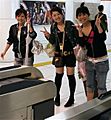V sign facts for kids
The V sign is a simple hand gesture that often means victory or peace. You make it by holding up your first two fingers (your pointer and middle finger) in a "V" shape, while keeping your other fingers curled down. It's a very well-known sign used all around the world!
-
Winston Churchill showing the V sign.
Contents
The V Sign: What It Means
The V sign has two main meanings, depending on how you use it and where you are.
Victory and Winning
One of the most famous uses of the V sign is for "victory." This meaning became very popular during World War II. People used it to show they believed they would win the war. It was a sign of hope and determination.
Peace and Friendship
Later, in the 1960s, the V sign also became a symbol for peace. Many people used it during protests against war, especially the Vietnam War. It showed a desire for peace and an end to fighting. Today, it's still a common way to say "peace" or "hello" in a friendly way.
How the V Sign Became Popular
The V sign has a long history, but it really took off in the 20th century.
World War II Symbol
During World War II, the British Broadcasting Corporation (BBC) helped make the V sign famous. They encouraged people in countries fighting against Nazi Germany to use it. It was a simple way for everyone to show their support and resistance. The "V" also stood for "Victoire" in French and "Vrijheid" in Dutch, both meaning "freedom" or "victory."
Famous People and the V Sign
Many important figures have used the V sign.
- Winston Churchill: The Prime Minister of the United Kingdom during World War II, Winston Churchill, often used the V sign. It became his signature gesture for victory.
- Richard Nixon: The former President of the United States, Richard Nixon, frequently used the V sign, especially when leaving office.
- Lech Wałęsa: A famous leader from Poland, Lech Wałęsa, used the V sign to symbolize the fight for freedom and democracy in his country.
The Peace Movement
In the 1960s and 1970s, the V sign was adopted by the counterculture movement. Young people and activists used it to protest war and promote peace. It became a universal symbol for peace and love.
Different Ways to Use the V Sign
While the V sign usually means victory or peace, it's important to know that in some places, if you show the V sign with your palm facing inward (towards yourself), it can be seen as rude or offensive. However, with your palm facing outward (away from you), it almost always means victory or peace.
It's a simple gesture, but it carries a lot of history and meaning!
Images for kids
-
Nixon departing the White House on 9 August 1974
-
An investigator flashes V-for-victory signs upon the 2006 arrival of material gathered by the Stardust spacecraft at the Johnson Space Center in Texas.
-
Lech Wałęsa and George H. W. Bush, July 1989
-
Resistance graffiti on a Norwegian road, depicting the V-sign together with the initials of King Haakon VII.
-
A German V-sign and slogan on the Palais Bourbon in occupied Paris. The banner beneath the "V" reads "Germany is Victorious on All Fronts".
See also
 In Spanish: V (seña) para niños
In Spanish: V (seña) para niños












